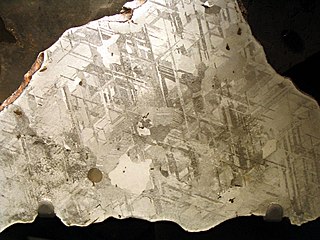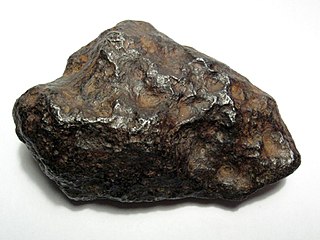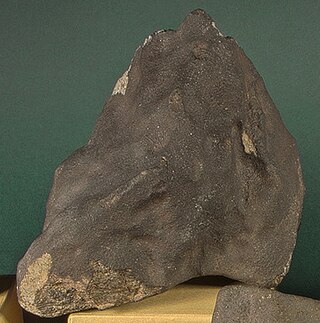
Kamacite is an alloy of iron and nickel, which is found on Earth only in meteorites. According to the International Mineralogical Association (IMA) it is considered a proper nickel-rich variety of the mineral native iron. The proportion iron:nickel is between 90%:10% and 95%:5%; small quantities of other elements, such as cobalt or carbon may also be present. The mineral has a metallic luster, is gray and has no clear cleavage although its crystal structure is isometric-hexoctahedral. Its density is about 8 g/cm3 and its hardness is 4 on the Mohs scale. It is also sometimes called balkeneisen.

Octahedrites are the most common structural class of iron meteorites. The structures occur because the meteoric iron has a certain nickel concentration that leads to the exsolution of kamacite out of taenite while cooling.

Terrestrial rocks are formed by three main mechanisms:

Widmanstätten patterns, also known as Thomson structures, are figures of long phases of nickel–iron, found in the octahedrite shapes of iron meteorite crystals and some pallasites.

Meteoric iron, sometimes meteoritic iron, is a native metal and early-universe protoplanetary-disk remnant found in meteorites and made from the elements iron and nickel, mainly in the form of the mineral phases kamacite and taenite. Meteoric iron makes up the bulk of iron meteorites but is also found in other meteorites. Apart from minor amounts of telluric iron, meteoric iron is the only naturally occurring native metal of the element iron on the Earth's surface.

Ataxites are a structural class of iron meteorites with a high nickel content and show no Widmanstätten patterns upon etching.

Hexahedrites are a structural class of iron meteorite. They are composed almost exclusively of the nickel–iron alloy kamacite and are lower in nickel content than the octahedrites. The nickel concentration in hexahedrites is always below 5.8% and only rarely below 5.3%.

Taenite is a mineral found naturally on Earth mostly in iron meteorites. It is an alloy of iron and nickel, with a chemical formula of Fe,Ni and nickel proportions of 20% up to 65%.

Iron meteorites, also called siderites or ferrous meteorites, are a type of meteorite that consist overwhelmingly of an iron–nickel alloy known as meteoric iron that usually consists of two mineral phases: kamacite and taenite. Most iron meteorites originate from cores of planetesimals, with the exception of the IIE iron meteorite group.

Count Alois von Beckh Widmanstätten was a printer and mineralogist from the Holy Roman Empire and then the Austrian Empire. His name is sometimes given as Alois von Beckh-Widmannstätten or Aloys Joseph Franz Xaver Beck Edler von Widmanstätten. He is known for recognizing a unique pattern of cross-hatching lines on the surface of iron-rich meteorites, now called Widmanstätten patterns, resulting from the cooling and crystallization of interstitial minerals. A crater on the Moon is named after Widmanstätten.

The Fukang meteorite is a meteorite that was found in the mountains near Fukang, China in 2000. It is a pallasite—a type of stony–iron meteorite with olivine crystals. It is estimated to be 4.5 billion years old.
Qidong is a L/LL5-an chondrite meteorite fallen in 1982 in China. After detonation a single individual specimen was found in the field. Other circumstances of fall and recovery were not reported.
Lac Dodon is an iron meteorite discovered by Roland Octerneau of Montreal on rural private property near Lac Dodon, Saint-Calixte, Quebec.

IAB meteorites are a group of iron meteorites according to their overall composition and a group of primitive achondrites because of silicate inclusions that show a strong affinity to winonaites and chondrites.

The Tamdakht meteorite fell near Ouarzazate, Morocco on 20 December 2008 producing a strewn field of approximately 25 kilometres (16 mi) by 2 kilometres (1.2 mi) and two small impact craters, one of about 1.1 metres diameter and 70 centimetres (28 in) depth at 31°09.8′N7°00.9′W and the other of about 20 centimetres (7.9 in) diameter and 10 centimetres (3.9 in) depth at 31°09.9′N07°02.3′W.
IIG meteorites are a group of iron meteorites. The group currently has six members. They are hexahedrites with large amounts of schreibersite. The meteoric iron is composed of kamacite.
The Bellsbank meteorite is a hexahedrite iron meteorite with abundant schreibersite. It is classified as a member of the IIG group. It was found in Bellsbank, South Africa in 1955.
This is a glossary of terms used in meteoritics, the science of meteorites.

IIAB meteorites are a group of iron meteorites. Their structural classification ranges from hexahedrites to octahedrites. IIABs have the lowest concentration of nickel of all iron meteorite groups. Most iron meteorites are derived from the metallic planetary cores of their respective parent bodies, but in the case of the IIABs the metallic magma separated to form not only this meteorite group but also the IIG group.

Uakitite is a mineral found in a single meteorite on Earth, called the Uakit meteorite, that fell in the Bauntovsky Evenkiysky District, in Republic of Buryatia, Russia. It was named after the region in which it was found, Uakit.













